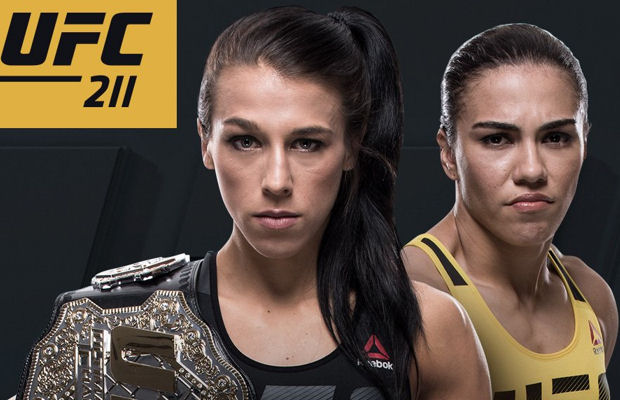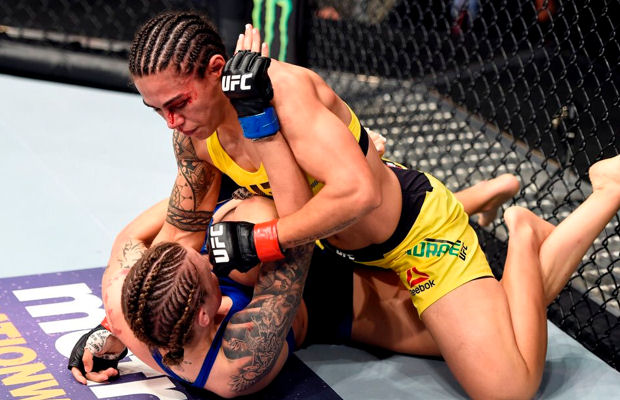
Jessica “Bate Estaca” Andrade has been on a bit of a roll for the past two years. After a series of uneven performances at bantamweight, Andrade dropped two weight classes and experienced a resurgence in the newly established strawweight division; as she went from fringe contender at 135 lbs, all the way to title challenger at 115 lbs.
Today we take a look at some of the fights that brought Andrade to the precipice of greatness, what those fights tell us about her as a fighter overall; as well as what we can expect on May 13th when she steps into the octagon versus pound for pound entrant and UFC champion Joanna Jędrzejczyk.
There are a few reasons a fighter drops weight, the first is they feel that their lack of size neutralizes any other advantages they have in regards to skill, strategy or athleticism. The second reason is that when a fighter has specific limitations regarding their balance of skills or depth of overall skills; in instances such as that a fighter leans on attributes such as size, strength, durability, physicality and power to make up for a lack of strategic awareness and legitimately applicable technical skill.
This is the circumstance that prompted the change in weight divisions for “Bate Estaca”. During her time as a bantamweight two things became apparent; one that physicality, pace, physical strength were huge parts of her game; secondly, when Andrade’s physical ability wasn’t a clear determining factor in a fight she just wasn’t less effective, she was completely ineffective.
This point was highlighted by the fact that all three of her losses were to opponents she couldn’t physically dominate for the length of a fight (Carmouche, Reneau and Pennington); as well as the fact that these losses were all by some form of stoppage. While the large majority of her wins have come by decision and against women who didn’t have winning records in the UFC (Sexton, Pacheco and Moras).
The uneven results at a higher weight prompted Jessica to move to strawweight, and for the better part of her time there we didn’t really know what to make of her in spite of the fact she kept winning; the fact was that Andrade wasn’t winning because of any refinement of technique, layered strategy or range of skills; she was winning based off the god given tools she had that went from contributing factors to decisive ones as a result of competing at a lower weight.
In her first two forays into the division she faced two ranked fighters, one former title challenger Jessica Penne; the other being Joanne “Jojo” Calderwood. Both wins were dominating and decisive, leading many to believe that not only had Andrade made the right decision in moving down two divisions; but that we had been introduced to a new and improved “Bate Estaca”.

She showed a previously unseen punching power, offensive output and improved finishing ability on the ground; or so it seemed, but upon further inspection a different story was told. In the case of Penne, you had a former atomweight champion masquerading as a strawweight; which instantly created questions regarding the ability to distribute damage and her ability to absorb it. These two things are of huge importance when facing an opponent who competed three full weight classes up from the most effective weight she competed at.
In the case of Calderwood, Andrade was facing a fighter who was the polar opposite in regards to technique and the ability to apply it and was very much like her in that she leaned on her size, strength, physicality and toughness to win her fights by limiting the importance of the holes she has in her game (defense, slow starts and cardio). So while it seemed we were seeing a new improved Jessica, the fact was we weren’t; we were being exposed to the same old Jessica, she hadn’t changed.
But the physical characteristics and attributes of the fighters she faced had changed and that made all the difference in the world in regards to how she won and how much she won. She was facing fighters who lacked the necessary physical skills to take advantage of any of the technical and strategical shortcomings Andrade had in her game.
There are a few ways to approach a fight with Andrade with any hope of success; the first and most unlikely at strawweight would be to meet her head on, overwhelming her with your own strength and physicality; building on that physical dominance and attacking her in the spots she is weakest technically.
The second way to beat a fighter of Andrade’s ilk is to punish her with power, using that to blunt her aggression and limit her willingness to bring the fight to that realm, thereby taking away her ability to use volume and pressure to overwhelm an opponent. The third and final approach to beating her is to use a combination of top end athleticism and high paced and diverse offense on the feet to out position her, out slick her and eventually outwork her on the way to breaking her down and pulling away late.
No opponent she had faced had the physical tools to pull off any of those game plans. Calderwood lacked the defensive footwork and grappling/wrestling to be able to control the pace and place of the fight until she could bring her superior striking to bear. Penne lacked the power, durability to slow Andrade’s volume and forward pressure long enough to test her cardio or even attempt to effectively get her to the ground and use her considerable grappling skills.
At UFC Fight Night 104 that all changed, when “Bate Estaca” stood across the octagon from Angela “Overkill” Hill. Hill didn’t have the physicality or durability of Calderwood, nor did she have the physical length and technical efficiency on the ground possessed by Penne. But what she did have was hand speed, foot speed, explosiveness, mobility and offensive diversity in both her striking and wrestling game, which meant that Hill, unlike Penne and Calderwood, had a clear route to victory versus Andrade. Theoretically speaking, “Overkill” was in prime position to spring an upset and simultaneously jump start her own career in the UFC.
In part two we examine the Hill/Andrade title eliminator in depth, addressing what it told us about Andrade’s evolution as a fighter and what we could take from that fight and apply to her upcoming title tilt versus Strawweight champion and pound for pound entrant Joanna Jędrzejczyk.
Continue Reading – Don’t Sweat The Technique: The Ins & Outs of Jessica Andrade’s Game – Part Two
Photos via Zuffa









0 comments